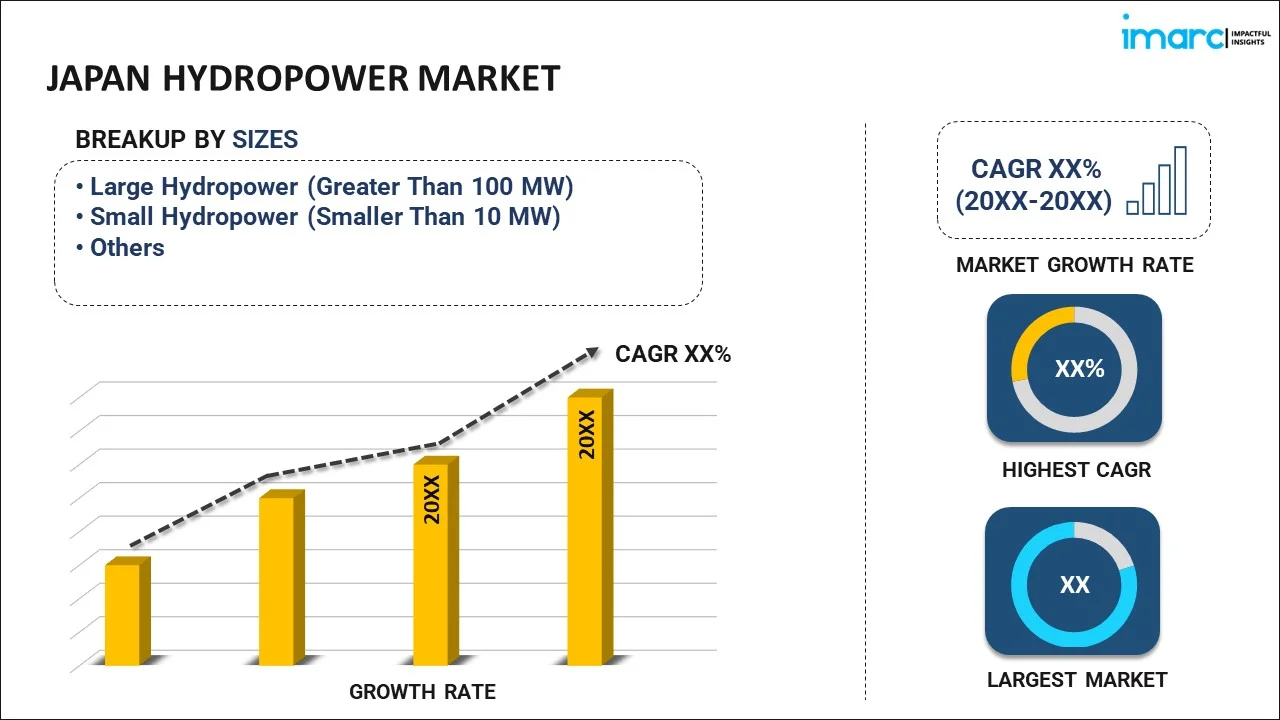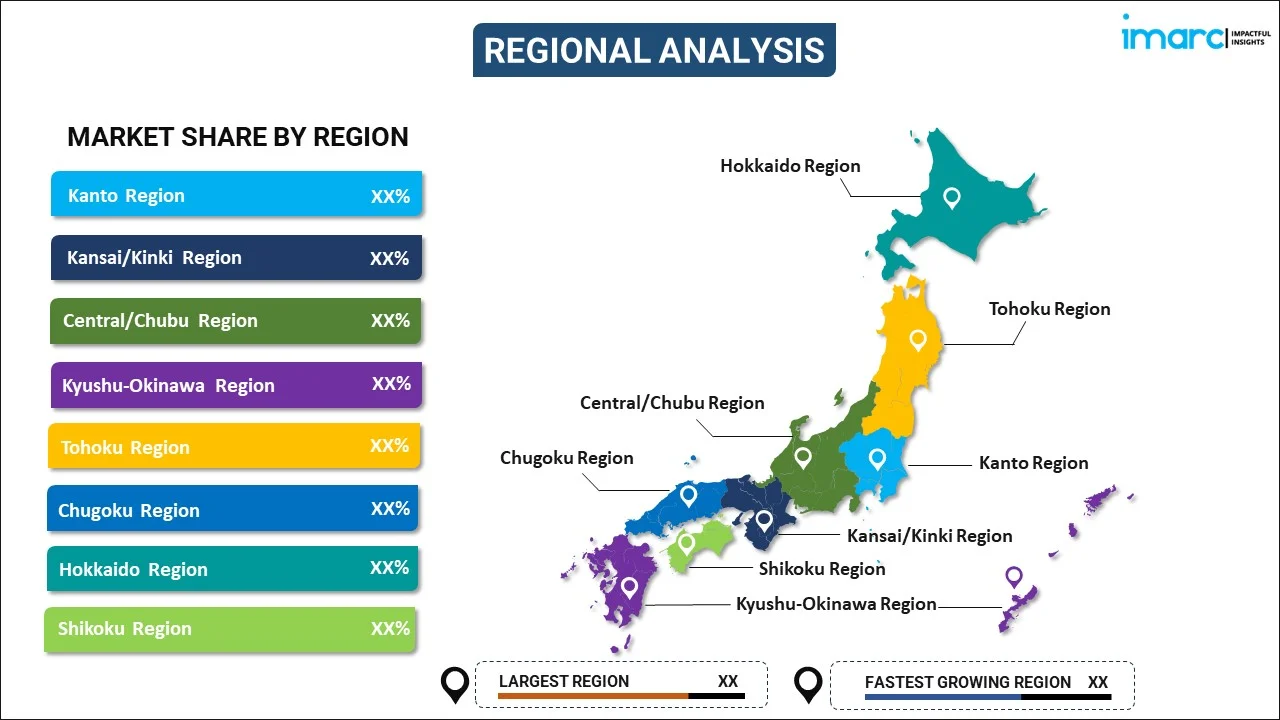
Japan Hydropower Market Report by Size (Large Hydropower (Greater Than 100 MW), Small Hydropower (Smaller Than 10 MW), and Others), Application (Industrial, Residential, Commercial), and Region 2025-2033
Market Overview:
Japan hydropower market size reached 88.5 TWh in 2024. Looking forward, IMARC Group expects the market to reach 112.4 TWh by 2033, exhibiting a growth rate (CAGR) of 2.69% during 2025-2033. The increasing advancements in various technologies, such as integration with the industrial internet of things (IIoT) solutions that can continuously monitor the energy levels generated by the plant, thereby enhancing operational efficiency, are primarily driving the market.
|
Report Attribute
|
Key Statistics
|
|---|---|
|
Base Year
|
2024 |
|
Forecast Years
|
2025-2033 |
|
Historical Years
|
2019-2024
|
| Market Size in 2024 | 88.5 TWh |
| Market Forecast in 2033 | 112.4 TWh |
| Market Growth Rate (2025-2033) | 2.69% |
Hydropower, also known as hydroelectric power, refers to a source of renewable energy that can harness the energy of falling or flowing water in order to generate electricity. It involves the use of dams, reservoirs, and turbines to transform the kinetic energy of water into electrical power. Water is typically stored in a reservoir behind a dam, and when released, it flows through turbines connected to generators, causing them to spin and produce electricity. Hydropower has several advantages, including its renewable nature, low greenhouse gas emissions, as well as the ability to provide a reliable and consistent source of electricity. It has been used for centuries to grind grain and perform other mechanical tasks, but in the modern era, it plays a crucial role in meeting the world's energy needs. It is a clean and sustainable energy option that can limit the reliance on fossil fuels and mitigate the environmental impact of power generation.
Japan Hydropower Market Trends:
The hydropower market in Japan is poised for extensive growth in the coming years, primarily driven by a confluence of factors. Firstly, the increasing regional emphasis on renewable energy sources has positioned hydropower as a leading contender, as it is one of the cleanest and most reliable sources of electricity generation. Moreover, the growing concerns over climate change and the need to mitigate greenhouse gas emissions have prompted governments in Japan to invest heavily in sustainable energy solutions, further propelling the hydropower market forward. Additionally, technological advancements in hydropower infrastructure, including improved turbine designs and grid integration solutions, have enhanced the efficiency and cost-effectiveness of hydropower projects. This has bolstered investor confidence and attracted substantial capital to the sector, fostering market expansion. Moreover, supportive government policies, such as subsidies, tax incentives, and favorable regulations, have created a conducive environment for hydropower development, further fueling its market prospects. Apart from this, the emerging trend towards decentralized energy generation that can offer opportunities for smaller-scale hydropower projects is expected to drive the market in Japan during the forecast period.
Japan Hydropower Market Segmentation:
IMARC Group provides an analysis of the key trends in each segment of the market, along with forecasts at the country level for 2025-2033. Our report has categorized the market based on size and application.
Size Insights:

- Large Hydropower (Greater Than 100 MW)
- Small Hydropower (Smaller Than 10 MW)
- Others
The report has provided a detailed breakup and analysis of the market based on the size. This includes large hydropower (greater than 100 MW), small hydropower (smaller than 10 MW), and others.
Application Insights:
- Industrial
- Residential
- Commercial
A detailed breakup and analysis of the market based on the application have also been provided in the report. This includes industrial, residential, and commercial.
Regional Insights:

- Kanto Region
- Kansai/Kinki Region
- Central/ Chubu Region
- Kyushu-Okinawa Region
- Tohoku Region
- Chugoku Region
- Hokkaido Region
- Shikoku Region
The report has also provided a comprehensive analysis of all the major regional markets, which include Kanto Region, Kansai/Kinki Region, Central/ Chubu Region, Kyushu-Okinawa Region, Tohoku Region, Chugoku Region, Hokkaido Region, and Shikoku Region.
Competitive Landscape:
The market research report has also provided a comprehensive analysis of the competitive landscape in the market. Competitive analysis such as market structure, key player positioning, top winning strategies, competitive dashboard, and company evaluation quadrant has been covered in the report. Also, detailed profiles of all major companies have been provided.
Japan Hydropower Market Report Coverage:
| Report Features | Details |
|---|---|
| Base Year of the Analysis | 2024 |
| Historical Period | 2019-2024 |
| Forecast Period | 2025-2033 |
| Units | TWh |
| Scope of the Report | Exploration of Historical and Forecast Trends, Industry Catalysts and Challenges, Segment-Wise Historical and Predictive Market Assessment:
|
| Sizes Covered | Large Hydropower (Greater Than 100 MW), Small Hydropower (Smaller Than 10 MW), Others |
| Applications Covered | Industrial, Residential, Commercial |
| Regions Covered | Kanto Region, Kansai/Kinki Region, Central/ Chubu Region, Kyushu-Okinawa Region, Tohoku Region, Chugoku Region, Hokkaido Region, Shikoku Region |
| Customization Scope | 10% Free Customization |
| Post-Sale Analyst Support | 10-12 Weeks |
| Delivery Format | PDF and Excel through Email (We can also provide the editable version of the report in PPT/Word format on special request) |
Key Questions Answered in This Report:
- How has the Japan hydropower market performed so far and how will it perform in the coming years?
- What has been the impact of COVID-19 on the Japan hydropower market?
- What is the breakup of the Japan hydropower market on the basis of size?
- What is the breakup of the Japan hydropower market on the basis of application?
- What are the various stages in the value chain of the Japan hydropower market?
- What are the key driving factors and challenges in the Japan hydropower?
- What is the structure of the Japan hydropower market and who are the key players?
- What is the degree of competition in the Japan hydropower market?
Key Benefits for Stakeholders:
- IMARC’s industry report offers a comprehensive quantitative analysis of various market segments, historical and current market trends, market forecasts, and dynamics of the Japan hydropower market from 2019-2033.
- The research report provides the latest information on the market drivers, challenges, and opportunities in the Japan hydropower market.
- Porter's five forces analysis assist stakeholders in assessing the impact of new entrants, competitive rivalry, supplier power, buyer power, and the threat of substitution. It helps stakeholders to analyze the level of competition within the Japan hydropower industry and its attractiveness.
- Competitive landscape allows stakeholders to understand their competitive environment and provides an insight into the current positions of key players in the market.
Need more help?
- Speak to our experienced analysts for insights on the current market scenarios.
- Include additional segments and countries to customize the report as per your requirement.
- Gain an unparalleled competitive advantage in your domain by understanding how to utilize the report and positively impacting your operations and revenue.
- For further assistance, please connect with our analysts.
 Inquire Before Buying
Inquire Before Buying
 Speak to an Analyst
Speak to an Analyst
 Request Brochure
Request Brochure
 Request Customization
Request Customization




.webp)




.webp)












